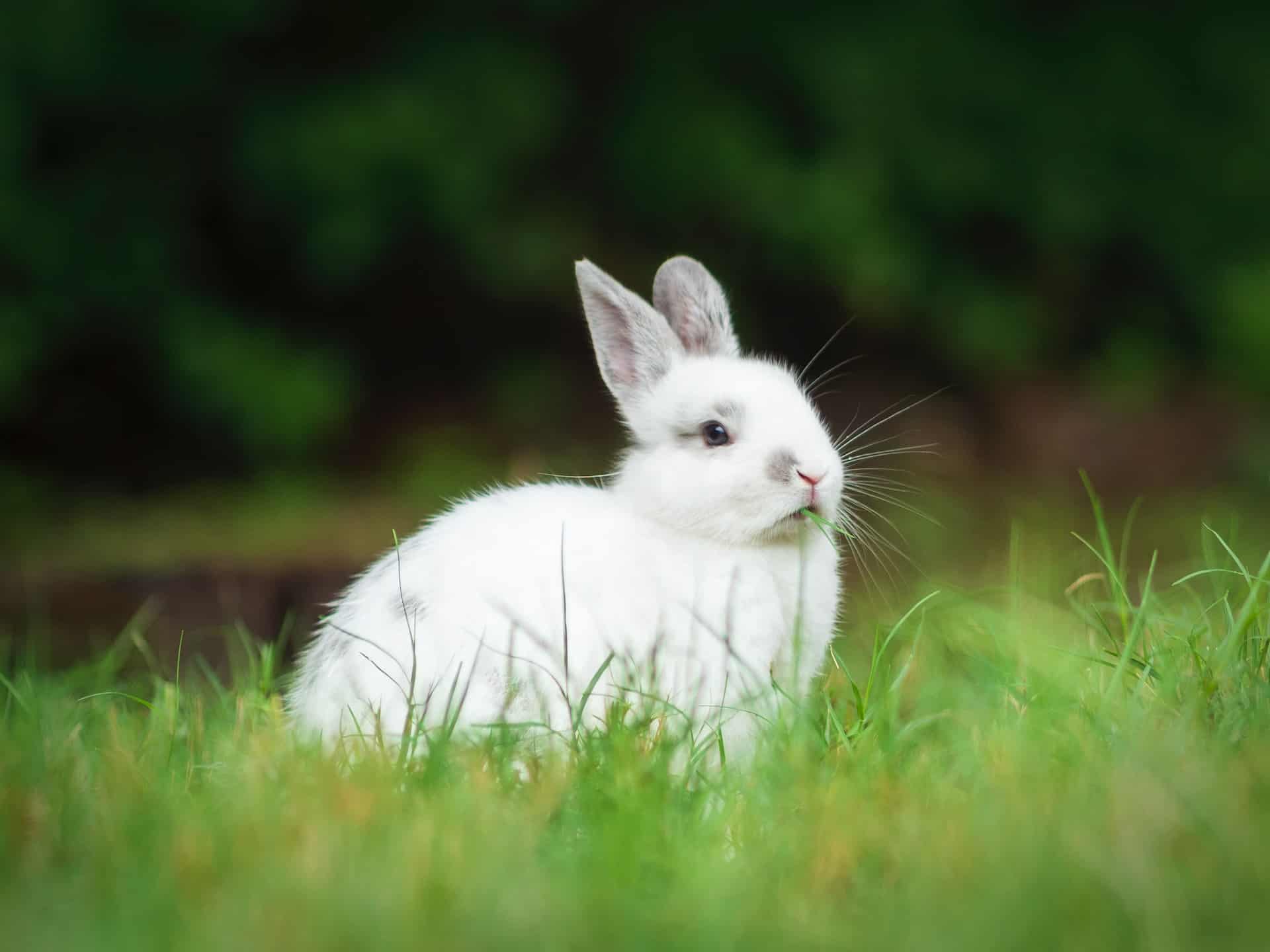| TL;DR: Adult rabbits have 28 teeth, including six incisors and 22 cheek teeth. They have an elodont dentition, meaning their teeth will constantly grow throughout their life. Overgrowth is one of the most common problems, as well as teeth misalignment (malocclusion). To keep your rabbit’s dental health in check, provide a balanced diet rich in fiber and grass hay. Additionally, ensure they have appropriate items to chew on, including the right amount of calcium in their diet and access to sunlight. Their overall well-being is closely tied to their dental health. |
When we think of bunnies, their adorable hopping around, cute nose wiggles and constant nibbling instantly come to mind. And then their iconic teeth, of course.
The well-being of these cute, fluffy pets is intricately linked to their dental care. However, rabbits are prone to dental issues and detecting the signs can be tricky.
This is why we will explore the ins and outs of rabbit teeth in this article. We’ll learn about the different types and how many they have. Plus, we’ll discover essential dental care tips to keep your rabbits happy and healthy. So, bunny lover, let’s hop in and ensure those chompers stay in top shape.
Rabbits’ Teeth Explainer
Like guinea pigs, rabbits have an elodont dentition. That means their teeth are ever-growing.
Bunny’s incisors can grow nearly a tenth of an inch per week. Besides, they have a radicular dentition. Instead of having teeth roots, enameled teeth grow below the gumline. Rabbits have two sets of teeth over their lifetime. Initially, they have a set of deciduous (primary) teeth totaling 16.
However, as early as three to five weeks of age, these milk teeth are entirely replaced by their 28 adult teeth.
Now let’s explore rabbits’ different types of permanent teeth:
???? INCISORS: these are the prominent teeth at the front of a rabbit’s mouth. Rabbits have a total of six incisors, although two of them are not visible. There are two pairs in the upper jaw — the ones at the front and a smaller pair, called peg teeth, located directly behind; and one last pair in the lower jaw, aligned with the upper ones. The chisel-shaped chompers have evolved to bite off grass, hay and high-fiber plants and to break them down into smaller chunks for the back teeth to grind up.
???? PREMOLARS: there are six upper-premolars (three on each side) and four lower-premolars (two on each side), making a total of ten.
???? MOLARS: There is a total of 12 molars evenly distributed. There are six upper molars and six lower molars.
Both molars and premolars, also called cheek teeth, are excellent grinders that break down food before swallowing and digestion. Interestingly, rabbits’ lower jaw is wider than the upper jaw, so their maxillary and mandibular teeth never touch. As a result, rabbits chew both up and down and side-to-side. This helps them keep their constantly growing teeth in check.
Rabbits may even grind their teeth together when they are not eating. This behavior, known as purring, indicates that a bunny is happy and comfortable.
| ????Rabbit Fact: Unlike dogs and cats, bunnies don’t have canine teeth, as their dentition has explicitly evolved for their plant-based diet. Also, there is a noticeable gap between their front incisors and rear cheek teeth called diastema. |
Causes of Dental Disease in Rabbits (And How To Spot Them)
Pet rabbits are more prone to dental problems than their wild counterparts. This is related to potential congenital dental issues — most common in dwarf breeds — injuries and improper diet.
A diet rich in fibrous and nutritious food is crucial for a healthy rabbit dentition. If dental health deteriorates, two common dental issues can occur:
????OVERGROWTH: When a rabbit doesn’t eat enough high-fiber food, its teeth won’t wear down properly, causing them to grow too long. Overgrowth is most noticeable in incisors but can occur in any tooth. Specifically, the lower molars can become excessively long and create a bridge that traps the rabbit’s tongue.
Additionally, overgrown cheek teeth may collide, affecting the incisors’ alignment and hindering proper wear down. These issues can lead to other complications like malocclusion.
????MALOCCLUSION: This occurs when the upper and lower jaws don’t align properly, so the top and bottom teeth don’t wear down evenly when the rabbit chews. It can cause severe ulcers, making it hard for rabbits to chew or eat. And since the teeth aren’t worn down properly, the misalignment can worsen over time and require extensive surgery later.
5 Clinical Signs of Dental Disease in Rabbits
As prey animals, rabbits are skilled at hiding any discomfort they may experience. This means that dental issues can go unnoticed by pet parents until they have become advanced.
Also, when one tooth is affected, it can gradually impact the rabbit’s overall dental well-being.
That’s why it’s crucial to be vigilant and watch out for any subtle signs that could indicate dental problems in your pet bunny. While regular visits to the vet are important, it’s equally essential to pay attention to any signs of discomfort at home.
But how can you tell if your bunny is experiencing dental issues?
Here are some clinical signs to look out for.
1. Changes in diet and possible weight loss
A common sign has to do with their eating habits. Rabbits with dental problems may lose interest in fibrous foods like hay, leading to an incomplete diet. They may show interest in food but refrain from eating it. On the other hand, even if their appetite remains unchanged, dental problems can hinder their ability to chew and digest properly.
All of this can lead to anorexia, reduced food intake, selectiveness towards specific food items and difficulty holding food in their mouth. Lastly, changes in eating patterns can result in changes in their feces (output, size and appearance).
2. Unusual discharges and hypersalivation
When teeth, especially the upper incisors, become overgrown, they can trigger inflammation near the tear ducts and nasal sinuses. As a result, tears fail to drain correctly, streaming down the face instead and potentially leading to infections.
Abnormal nasal discharge can also occur. Additionally, drooling and saliva buildup in the corners of the mouth, chin and dewlap may indicate oral pain and/or difficulty properly closing the mouth.
3. Facial swelling and lumps
Visible lumps or abscesses (pus-filled pockets) indicate an advanced stage of dental disease, often associated with overgrowth. Elongated teeth can become sharp and gradually erode the soft tissues surrounding the teeth. This can allow abscess-causing bacteria to enter into the gums.
| ????Pro Tip: gently feel around your rabbit’s head and jaw, paying attention to any bumps or lumps that may be present on one side but not the other. By performing this simple check regularly, you can catch any potential lumps or infections in their early stages and promptly address any possible concerns. |
4. Teeth-grinding
Not all tooth grinding is a positive sign. While gentle purring indicates happiness and relaxation, teeth-grinding can signify pain or stress. Different body language differences help identify each other besides the sound they make. When rabbits are purring, they appear calm and content.
However, when gritting their teeth together in pain, they often adopt a hunched position or display signs of discomfort.
5. Lack of grooming
Rabbits are thorough groomers. Matted hair accumulated on their forelimbs could mean they are grooming discharge from their eyes, nose, or mouth instead of focusing on their fur. Also, since rabbits groom themselves using incisors, malocclusion or overgrown front teeth would interfere with their grooming routine.
4 Rules For Prevention of Dental Disease in Rabbits
Unlike dogs or cats, rabbits don’t need regular teeth brushing since their teeth are constantly worn down and renewed. However, as prone to dental issues as rabbits are, it’s crucial to have them checked by a rabbit-savvy veterinarian at least once a year.
In addition to regular vet visits, proper husbandry and a balanced diet are vital for preventing dental disease in rabbits.
To help maintain your rabbit’s dental health in top shape, consider a few things:
Rule 1: Fiber is key
Make sure your rabbit always has access to high-quality grass hay, specifically timothy hay. A fiber-rich diet, including plenty of timothy hay and fibrous, green, leafy vegetables, promotes chewing and encourages the grinding motions of the jaw that benefit tooth wear and oral health. Chewing hay also stimulates saliva production, which aids in optimal digestion.
| ????Pro-tip: Give your pet bun fresh and high-quality grass hay. If possible, avoid brown, dusty hay often found in pet stores, as it may not be as appealing. Make hay readily available, stuffing it into your bunny’s favorite toys or mixing it with their favorite foods. |
Rule 2: Limit pellet intake
Unlike fibrous grasses and hay, rabbits’ cheek teeth easily crush pellets. This reduces the grinding and lateral chewing motion necessary for proper tooth wear.
Rule 3: Maintain Calcium Balance
Calcium is vital for rabbits to maintain strong teeth and bones, especially in young rabbits. They are susceptible to dental and bone issues if fed low-calcium foods early in life. Including alfalfa hay in their diet is a good way to provide them with the necessary calcium.
However, as rabbits reach adulthood, their calcium requirements change. Providing excessive calcium can even lead to urinary tract problems. Adult rabbits should be given moderate dietary calcium, ranging from 0.5% to 1.0% and alfalfa should be replaced with timothy hay.
Rule 4: Harness the Power of Sunlight
Sunlight is vital for rabbits’ well-being as it stimulates vitamin D production, which is essential for calcium absorption and the development of strong teeth, bones, and healthy skin. Indoor bunnies often lack natural sunlight exposure, leading to vitamin D deficiency.
To prevent this, provide at least one hour of daily sun exposure. Even indoors, find a sunny room for your bunny to bask in its warm glow. This simple practice goes a long way in keeping your bunnies healthy and happy.
Final Thoughts
To keep your bunny’s teeth in tip-top shape, prevention is the name of the game. By understanding their eating habits and promptly addressing any changes, you can stay ahead of potential dental complications. Don’t wait for problems to arise — be proactive.
Structure their diet to promote healthy chewing and maximize their overall health. A diet rich in fibrous hay and vegetables will minimize dental problems and fulfill their natural desire to chew.
Plus, it might save your furniture from becoming a rabbit’s chewing playground.
Regular check-ups at the vet are a must, even if your pet bun appears to have no dental troubles. These visits allow early detection of dental, weight, or other health concerns. It’s the best way to keep your rabbit smiling and thriving.
| SOURCES Hamlin, J. (2013). Causes, examination and treatment of dental disease in rabbits. theveterinarynurse.com Hess, L. (2016). Rabbit Dental Care 101. petmd.com Hess. L; Axelson, R. (2023). Dental Disease in Rabbits. vcahospitals.com House Rabbit Society (2013). Dental Disorders in Rabbits. rabbit.org Long Island Bird & Exotics Veterinary Clinic. (2016). Rabbit Care Guide. birdexoticsvet.com Missouri House Rabbit Society (2016). Hay & Dental Health. mohrs.org Noonan, B. (2023). Dental Anatomy and Disease of the Domestic Rabbit (Oryctolagus cuniculus). mspca.org Van Praag, E. (2023). Common dental disorders of rabbits. medirabbit.com |





